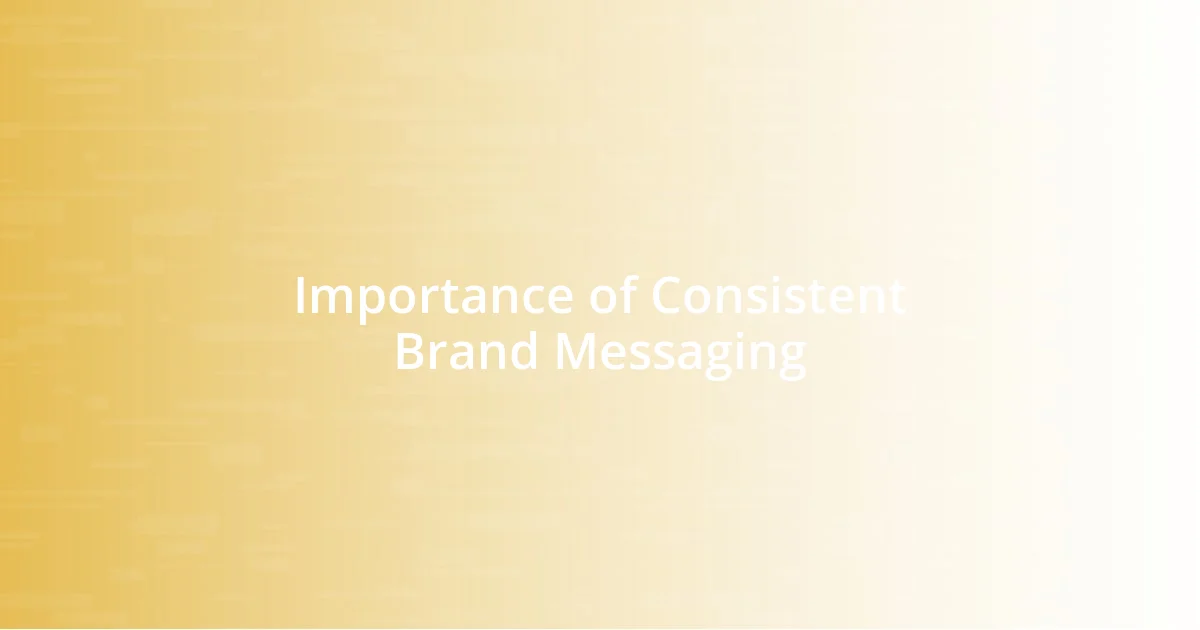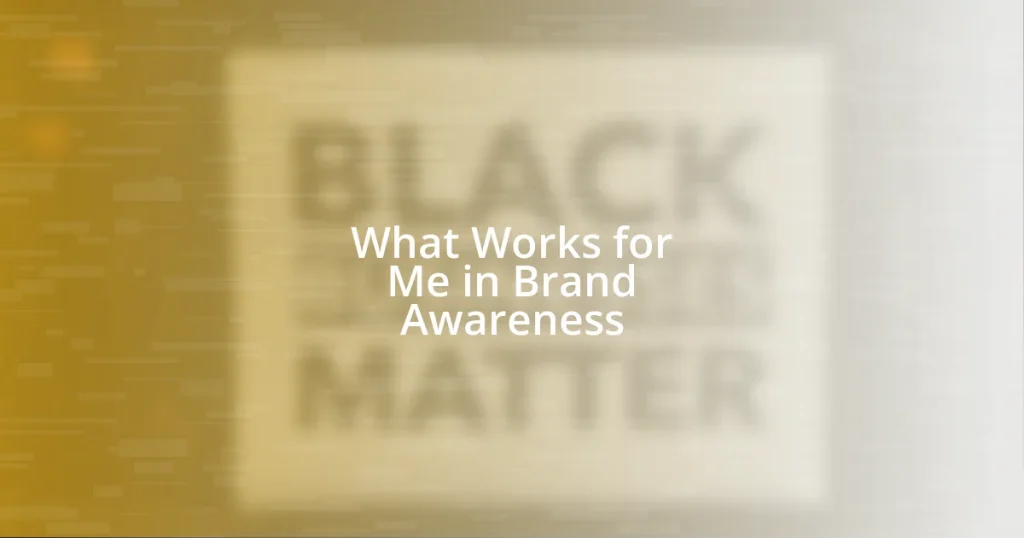Key takeaways:
- Consistency in brand messaging across channels fosters trust, recognition, and stronger relationships with the audience.
- Identifying and regularly revisiting your target audience allows for tailored content that engages effectively with their evolving needs.
- Flexibility, storytelling, and channel collaboration enhance engagement and create deeper emotional connections with the audience.

Introduction to Cross-Channel Branding
Cross-channel branding is all about creating a cohesive identity across various platforms. From my own experience, I’ve seen how a consistent brand message can resonate differently depending on the channel. It’s fascinating to consider how a single logo or tagline can elicit feelings of trust and familiarity in a busy social media feed or a sleek email campaign.
When I think about my journey with cross-channel branding, I remember how daunting it felt at first. How do I capture the essence of my brand in a tweet versus a longer blog post? It’s a dance that requires flexibility and an understanding of each platform’s nuances. Through trial and error, I learned to tweak my approach, ensuring that while the core message remained the same, the presentation varied to suit the audience’s expectations.
The emotional connection that stems from effective cross-channel branding is something I’ve truly come to appreciate. I’ve observed that when brands successfully engage across multiple touchpoints, it builds trust and loyalty. Have you ever felt that special connection to a brand because of how they consistently show up in your life, whether through social media, email, or even advertising? I realized that this connection is not just a marketing tactic; it’s about forging a relationship that feels genuine and relatable.

Importance of Consistent Brand Messaging
The essence of consistent brand messaging lies in its ability to foster recognition and trust. When a brand communicates its message uniformly across different channels, it avoids confusion and strengthens its identity. I remember one campaign where I noticed that the brand I admired always used the same colors, tone, and messaging across their website, social media, and even customer service. It made me feel comfortable and familiar with them, as if I knew their personality without ever having met them.
Here are a few reasons why maintaining consistent brand messaging is crucial:
- Builds Trust: Consistency projects reliability. When customers know what to expect, they’re more likely to engage.
- Enhances Recognition: A visually and verbally cohesive brand is more memorable. This helps make your brand stand out in crowded markets.
- Strengthens Relationships: Familiarity breeds affection; a consistent voice deepens emotional connections with the audience.
- Supports Cross-Selling: When customers recognize a brand across platforms, they’re more inclined to explore multiple products or services offered, leading to increased sales.

Identifying Your Target Audience
Identifying your target audience is one of the most critical elements in any branding strategy. I vividly recall a time when I launched a new product without truly understanding who would be interested in it. Initially, my efforts felt scattered and unfocused, as I tried to appeal to everyone and ended up connecting with no one. I’ve since learned that a well-defined audience not only helps streamline marketing efforts but also enhances engagement. Think about it — how much easier is it to create tailored content that speaks directly to someone’s needs?
The process of identifying your audience involves digging deeper than basic demographics. I’ve found that creating detailed personas—imagined representations of your ideal customers—can provide invaluable insights. These personas take into account aspects like interests, pain points, and motivations. During my last campaign, defining a specific persona helped me select targeted platforms and messaging that resonated deeply. I felt energized seeing positive responses from the audience I had accurately identified.
Revisiting your audience on a regular basis is equally important. Things change, and so do the people you want to reach. I experienced a shift in my own audience after a significant event in the industry. What once appealed to my previous audience didn’t resonate anymore. By evaluating the changes and adapting my approach, I not only retained my audience but expanded it. It taught me flexibility, and I learned that staying in tune with my target audience is not just beneficial; it’s essential for ongoing success.
| Characteristic | Details |
|---|---|
| Demographics | Age, gender, income level |
| Psychographics | Values, interests, lifestyle choices |
| Behavioral Patterns | Buying habits, brand loyalty, product usage |

Choosing the Right Channels
When it comes to choosing the right channels for cross-channel branding, I often ask myself, “Where is my audience spending their time?” A couple of years ago, I invested significant resources into a vibrant Instagram campaign, convinced that visual storytelling would resonate with my brand’s aesthetic. However, I quickly rediscovered that my audience was far more engaged on LinkedIn. This shift taught me an important lesson: aligning your channels with your audience’s preferences is crucial for effective branding.
Diving deeper, the nature of each channel also influences how I communicate. For instance, I’ve gleaned that while Twitter allows for snappy, real-time interactions, an email newsletter serves as a more thoughtful way to delve into detailed content. I find myself constantly adapting my tone and approach based on the platform, which enriches my connection with the audience. Have you ever noticed how some brands thrive because they match their messaging to the nuances of each channel? That’s no coincidence—it’s intentional strategy at play.
Ultimately, testing various channels has often led me to unexpected gems. I remember launching a podcast as an experiment, thinking it was merely a side project. To my surprise, it quickly developed a loyal following and became a significant vehicle for brand storytelling. Reflecting on this experience, I’ve come to realize that embracing experimentation not only broadens my reach but often uncovers deeper connections with listeners who value authenticity. It’s a reminder that the right channels may not always be the most obvious ones, and sometimes, you just have to take a chance!

Creating a Unified Content Strategy
Creating a unified content strategy is truly about weaving together diverse messages into a harmonious narrative. I vividly remember a time when I posted separate content across channels without any overarching theme. The result was a disconnection that left my audience confused. It’s essential to ensure that every piece of content, whether a blog post, social media update, or email newsletter, echoes the same core message and values. Have you ever felt lost when encountering a brand that seemed to want to say everything at once? That’s the exact pitfall to avoid.
To achieve this harmony, I’ve found it incredibly helpful to establish a clear content calendar that outlines key themes and messages across all platforms. There was a phase in my branding journey where I neglected this step, leading to sporadic posts that felt more like an afterthought. Once I implemented a calendar, I noticed a vast improvement in engagement and clarity. With everything mapped out, it became easier to lend a cohesive voice and vision; my audience started to see the brand story unfold seamlessly across all channels.
Finally, remember that visual consistency is crucial. I once revamped my brand’s look and feel—including colors, logos, and images—toward a more modern aesthetic. However, I went overboard and created a mishmash of visuals that lacked uniformity. It was only when I focused on creating a distinct visual identity that reflected our core message, supported by a cohesive content plan, that I truly captured my audience’s attention. Isn’t it fascinating how a consistent look can elevate a brand and foster a sense of trust? This experience taught me that every visual element works hand-in-hand with content, enriching the overall brand experience for my audience.

Measuring Brand Engagement Across Channels
Measuring brand engagement across different channels can often feel like piecing together a complex puzzle. I recall a time when I meticulously tracked engagement metrics like likes, shares, and comments on social media while completely overlooking email open rates. This oversight made me realize that each channel has its own set of KPIs (Key Performance Indicators) important for gauging effectiveness. Have you ever found yourself trapped in the allure of vanity metrics without understanding their true impact on your brand’s goals? It’s critical to evaluate channel-specific metrics that truly align with your overarching objectives.
I’ve learned the value of qualitative feedback as a complementary measurement tool. For instance, after hosting a webinar, I actively sought participant feedback through follow-up surveys. The responses not only provided insights into audience preferences but also revealed unexpected engagement drivers that numbers alone couldn’t convey. It’s fascinating how a simple question can open the floodgates to valuable conversations, isn’t it? Engaging with your audience on a personal level often enriches the data you collect and helps build stronger connections.
At the end of the day, the real magic happens when you blend quantitative and qualitative insights to create a more holistic view of brand engagement. One memorable experience for me was launching an integrated campaign that encouraged feedback across channels—social media, email, and even live events. This approach opened up channels of dialogue I never anticipated and helped me refine my strategy based on an amalgamation of metrics and personal stories. I realized that the numbers tell one part of the story, but the human element often adds the depth we crave in our branding efforts. Isn’t it incredible how engagement transcends data and speaks to the very heart of brand loyalty?

Lessons Learned from My Experience
In my journey with cross-channel branding, one of the biggest lessons I learned is the importance of adaptability. I remember launching a campaign that I thought was perfect, only to find my audience responding differently than I expected. It hit me that being rigid in your strategy can alienate potential customers. Don’t you think flexibility allows for genuine connections? Adapting messages based on real-time feedback has not only enhanced my engagement but also strengthened my relationship with my audience.
Another crucial takeaway was the power of storytelling. Early on, I struggled to convey my brand’s essence in a singular, impactful way. Then I decided to weave personal anecdotes into my messaging. I vividly recall sharing a story about a small success that resonated deeply with my audience. Their responses were overwhelmingly positive, proving to me that authenticity fosters relationships. Who doesn’t appreciate a story that speaks to their experiences, right? This shift made me realize that every touchpoint is an opportunity to create an emotional connection.
Lastly, collaboration across channels emerged as a game changer for me. I learned firsthand the beauty of integrating efforts—for instance, a behind-the-scenes look on social media that linked seamlessly to a detailed blog post. It felt rewarding to see how each piece contributed to a larger narrative, enriching the audience’s experience. Does it surprise you how synergy can be such a driving force in branding? The lesson here was clear: effective cross-channel branding requires a concerted effort where every voice contributes to the shared story.















